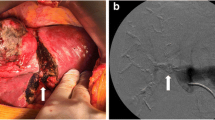Abstract
Surgical resection is the best option for prolonged survival in patients with primary or secondary liver tumors. A sufficient future liver remnant (FLR) volume is needed to prevent post-hepatectomy liver failure (PHLF). With the aim of increasing FLR, a new two-step technique has been recently developed. Our aim is to report our initial experience with associating liver partition and portal vein ligation for staged hepatectomy (ALPPS) technique. Analysis was conducted of ten patients previously considered locally unresectable because of small FLR. During first surgical step liver parenchymal partition and portal vein ligation was performed. Seven days after the first procedure, once volumetric and functional studies have demonstrated an appropriate FLR volume, the resection of the deportalized hemiliver was achieved. This technique was successfully performed in all ten patients (feasibility 100 %). Six were male with mean age of 55.2 years (range 39–77). Mean preoperative FLR volume and FLR/total liver volume were 408.4 ml and 27.8 %. Mean postoperative FLR volume was 733 ml representing a mean volume increase of 325 ml or 82 % (range 31–140) (p < 0.0001). All resections were R0 (4 right hepatectomies, 5 right trisectionectomies and 1 left trisectionectomy). There were two grade A post-hepatectomy liver failures. Morbidity was 40 % and mortality 0 %. With a mean follow-up of 187 days, disease-free survival and overall survival were 80 and 100 %, respectively. ALPPS induces a great and fast FLR hypertrophy allowing R0 resections in patients otherwise considered unresectable because of small FLR volume, without severe PHLF and low mortality in experience centers. Further experience is needed to determine long-term outcomes.



Similar content being viewed by others
References
Adam R, Laurent A, Azoulay D et al (2000) Two-stage hepatectomy: a planned strategy to treat irresectable liver tumors. Ann Surg 232:777–785
Charnsangavej C, Clary B, Fong Y et al (2006) Selection of patients for resection of hepatic colorectal metastases: expert consensus statement. Ann Surg Oncol 13:1261–1268
Ferrero A, Vigano L, Polastri R et al (2007) Postoperative liver dysfunction and future remnant liver: where is the limit? Results of a prospective study. World J Surg 31:1643–1651
Clavien PA, Petrowsky H, DeOliveira ML, Graf R (2007) Strategies for safer liver surgery and partial liver transplantation. N Engl J Med 356:1545–1559
Capussotti L, Vigano L, Giuliante F et al (2009) Liver dysfunction and sepsis determine operative mortality after liver resection. Br J Surg 96:88–94
Tucker ON, Heaton N (2005) The ‘small for size’ liver syndrome. Curr Opin Crit Care 11:150–155
Ribero D, Chun YS, Vauthey JN (2008) Standardized liver volumetry for portal vein embolization. Semin Interv Radiol 25:104–109
Makuuchi M, Thai BL, Takayasu K et al (1990) Preoperative portal embolization to increase safety of major hepatectomy for hilar bile duct carcinoma: a preliminary report. Surgery 107:521–527
Jaeck D, Oussoultzoglou E, Rosso E et al (2004) A two-stage hepatectomy procedure combined with portal vein embolization to achieve curative resection for initially unresectable multiple and bilobar colorectal liver metastases. Ann Surg 240:1037–1049 (discussion 1049–1051)
Kianmanesh R, Farges O, Abdalla EK et al (2003) Right portal vein ligation: a new planned two-step all-surgical approach for complete resection of primary gastrointestinal tumors with multiple bilateral liver metastases. J Am Coll Surg 197:164–170
Schnitzbauer AA, Lang SA, Goessmann H et al (2012) Right portal vein ligation combined with in situ splitting induces rapid left lateral liver lobe hypertrophy enabling 2-staged extended right hepatic resection in small-for-size settings. Ann Surg 255:405–414
de Santibanes E, Clavien PA (2012) Playing Play-Doh to prevent postoperative liver failure: the “ALPPS” approach. Ann Surg 255:415–417
Alvarez FA, Iniesta J, Lastiri J et al (2011) New method of hepatic regeneration. Cir Esp 89:645–649
de Santibanes E, Alvarez FA, Ardiles V (2012) How to avoid postoperative liver failure: a novel method. World J Surg 36:125–128
Vauthey JN, Abdalla EK, Doherty DA et al (2002) Body surface area and body weight predict total liver volume in western adults. Liver Transpl 8:233–240
Dindo D, Demartines N, Clavien PA (2004) Classification of surgical complications: a new proposal with evaluation in a cohort of 6336 patients and results of a survey. Ann Surg 240:205–213
Rahbari NN, Garden OJ, Padbury R et al (2011) Posthepatectomy liver failure: a definition and grading by the International Study Group of Liver Surgery (ISGLS). Surgery 149:713–724
Capussotti L, Muratore A, Baracchi F et al (2008) Portal vein ligation as an efficient method of increasing the future liver remnant volume in the surgical treatment of colorectal metastases. Arch Surg 143:978–982 (discussion 982)
Elias D, De Baere T, Roche A et al (1999) During liver regeneration following right portal embolization the growth rate of liver metastases is more rapid than that of the liver parenchyma. Br J Surg 86:784–788
Kokudo N, Tada K, Seki M et al (2001) Proliferative activity of intrahepatic colorectal metastases after preoperative hemihepatic portal vein embolization. Hepatology 34:267–272
Mueller L, Hillert C, Moller L et al (2008) Major hepatectomy for colorectal metastases: is preoperative portal occlusion an oncological risk factor? Ann Surg Oncol 15:1908–1917
Conflict of interest
None.
Author information
Authors and Affiliations
Corresponding author
Rights and permissions
About this article
Cite this article
Sala, S., Ardiles, V., Ulla, M. et al. Our initial experience with ALPPS technique: encouraging results. Updates Surg 64, 167–172 (2012). https://doi.org/10.1007/s13304-012-0175-y
Received:
Accepted:
Published:
Issue Date:
DOI: https://doi.org/10.1007/s13304-012-0175-y




